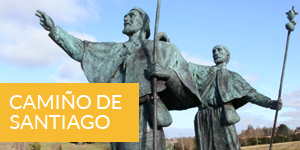- Accede I
- Regístrate I
- carrito
Moverse en la ciudad
Santiago de Compostela es una ciudad de estructura sencilla. Su centro es el llamado ‘casco histórico', que corresponde aproximadamente al espacio que desde el siglo XI en adelante fue delimitado por una muralla, hoy desaparecida. La denominación es extensible además a algunas calles limítrofes de esa gran zona monumental, pues entran bajo el plan de protección, conservación y rehabilitación trazado por el Ayuntamiento.
En el casco histórico se concentra buena parte de los monumentos visitables, un comercio muy activo, numerosos alojamientos y establecimientos gastronómicos, así como instituciones, museos, fundaciones y los edificios más antiguos de la Universidad de Santiago, pero también viviendas, mercados, cafés y bares que hacen de él un espacio vivo y dinámico.
Sus principales calles –rúas do Franco, Vilar y Nova-, de origen medieval, son paralelas entre sí y conducen desde los alrededores de la plaza de O Toural hacia las plazas catedralicias del Obradoiro, das Praterías y da Quintana, respectivamente. Atravesar la plaza del Obradoiro hacia el norte supone llegar a la rúa de San Francisco, desde donde se alcanzan la dársena de autobuses de Xoán XXIII y el Campus Norte de la Universidad.
Otra rúa paralela a las do Vilar y Nova, llamada Caldeirería –que comienza en la plaza do Toural llamándose Orfas y desemboca en la plaza de Cervantes como rúa do Preguntoiro- es una de las de mayor vocación comercial, lo mismo que las Algalias (de Arriba y de Abaixo) que parten de esta última plaza en dirección norte. Desde Cervantes es muy fácil llegar al Mercado de Abastos. Y como es parte del tramo urbano que recorren los peregrinos hacia la Catedral , la plaza del escritor también es buen punto de partida (andando en dirección contraria a los peregrinos por las rúas das Ánimas y Casas Reais) para alcanzar la Porta do Camiño y, desde ella, el complejo cultural de Bonaval. Alrededor, en torno a importantes conventos e iglesias, se extienden barrios tradicionales de la ciudad, como Sar al sureste, Belvís o San Pedro.
El punto donde se alzaba una de las antiguas puertas de la muralla, Porta Faxeira, es el acceso natural desde el casco histórico a la Alameda. Este parque urbano, que se extiende entre la zona monumental, el Ensanche y el Campus Sur universitario, es además punto de partida de una interesante ruta por las zonas verdes compostelanas, que permite rodear el casco histórico con magníficas vistas sobre los monumentos, y conocer algunas de las más destacadas obras de la arquitectura contemporánea en la ciudad.
Por esa Porta Faxeira, pero también por el punto llamado Porta da Mámoa –cercano a la rúa das Orfas- se accede además al Ensanche. Este es el nombre que recibe la primera ampliación urbana del casco histórico, trazada a principios del siglo XX y ubicada al sur de éste. sus límites son las rúas de Castrón Douro al este, la avenida de Romero Donallo al sur y Rosalía de Castro al oeste.
Las principales rúas del Ensanche son la del Hórreo (que parte de la plaza de Galicia, pasa por el Parlamento gallego y desemboca en la Estación de Trenes de Renfe); y sus paralelas, Doutor Teixeiro, Xeneral Pardiñas y Alfredo Brañas. Estas calles y sus vecinas –normalmente con un solo sentido de circulación- forman una zona que combina el uso habitacional con un activo y variado comercio, establecimientos hoteleros, de restauración y agitada vida nocturna de jueves a sábados.
Algunas de las principales avenidas y calles de la ciudad –en el sentido de las agujas del reloj, Galeras, Xoán XXIII, Santa Clara-Basquiños, Rodríguez de Víguri, Concheiros, Fontiñas, avenida de Torrente Ballester, avenida de Lugo, avenida de Antón Fraguas, Romero Donallo y Mestre Mateo- permiten salir de estos núcleos hacia barrios exteriores como Vite, Vista Alegre, San Caetano –con las dependencias administrativas de la Xunta, y aledaño a la estación de autobuses -, San Lázaro –sede del Palacio de Congresos y Exposiciones de Galicia, y punto por donde entra en Santiago el Camino Francés - ,Fontiñas –con un importante centro comercial cubierto llamado Área Central -, O Paxonal, Conxo, Santa Marta y A Choupana –vecino del Hospital Universitario -, entre otros, eminentemente residenciales, y al resto de las parroquias del municipio.













